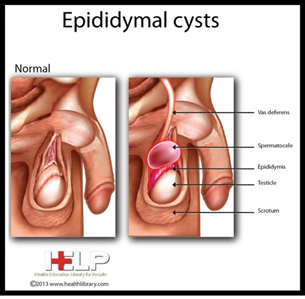What is an Epididymal cyst?
Epididymal cysts, or sometimes known as spermatocele are fluid filled sacs that develop in the epididymis (where the sperm from the testis collect before moving along the vas). They occur for a number of reasons but are always benign (non-cancerous) and generally cause mild discomfort only. They may vary in size from several millimetres to many centimeters.
It may feel like a scrotal lump either found on a physical examination by your doctor or discovered by self-inspection of the scrotum and testicles. They are generally felt separately to the testicle. A lump within the testicle itself is much more concerning and it could represent testicular cancer. If you feel a lump within the testicle please see your GP or urologist.
Epididymal cyst symptoms: –
- Pain or heaviness n the scrotum
- Discomfort and pressure if very large
How it is diagnosed – It can be diagnosed with a simple ultrasound to the scrotum. This will also look at the testicles to ensure that they are normal in appearance to exclude testicular cancer.
Treatment of – In most cases, no intervention is required once the diagnosis of an Epididymal cyst has been made. If the cyst becomes very large or is causing symptoms, it is possible to remove it with a small procedure.
Excision of an Epididymal cyst is a day procedure. It is performed under general anaesthetic and is relatively a quick procedure. The surgeon will make a small incision in the scrotum to excise the cyst and the wound will be closed using dissolving sutures.
An alternative to open surgery is to drain the fluid with a needle under ultrasound guidance. Both procedures are effective the short term, but the cysts are much more likely to reoccur back after the needle drainage.
Potential risks / side effects: –
- pain
- bleeding
- Swelling and bruising. You may find that the area around the operation site appears swollen and slightly bruising. This should settle after approximately 4 weeks
- Failure to improve your symptoms or pain
- recurrence
- Infection in the incision
What can I expect when I get home?
- A dressing to the wound. The dressing may fall off by itself or you may remove the dressing in the shower if it is still on after 48hours
- Stitches are dissolvable and you do not need to have them removed.
- Showering and hygiene are important. You may shower as per normal, however it is advisable to be gentle with washing and drying and not to use any harsh soaps or lotions
- Wear tight underwear to support the scrotum for up to 6 weeks. This is a guideline only and will help reduce the swelling and provide you with some scrotal support.
- You may get some bruising of the scrotum which will likely last a few days
- Take regular analgesia such as Panadol. We recommend you don’t take any anti-inflammatory tablets e.g. Nurofen for the first 48 hours as this can increase bleeding
- Your stitches will be dissolvable and will usually disappear after 2-3 weeks
- You should avoid heavy lifting or any other strenuous exercise for at least 4 weeks or otherwise told by your surgeon
NOTIFY GEELONG UROLOGY if you experience any of the following
- Fevers (temperatures over 37.5 degrees), sweats or shakes
- Increased discomfort, severe pain
- Heavy bleeding or any wound discharge
- Unable to pass urine
- Cloudy or offensive urine
FOLLOW UP APPOINTMENT
You will need an appointment for approximately 6 weeks after your surgery. If an appointment time is not given to you on discharge from hospital, you will need to phone Geelong Urology to make an appointment with your surgeon.
Geelong Urology 03 5229 9105 during business hours
Or leave a message on the After-Hours Urology Paging Service 03 9387 1000

